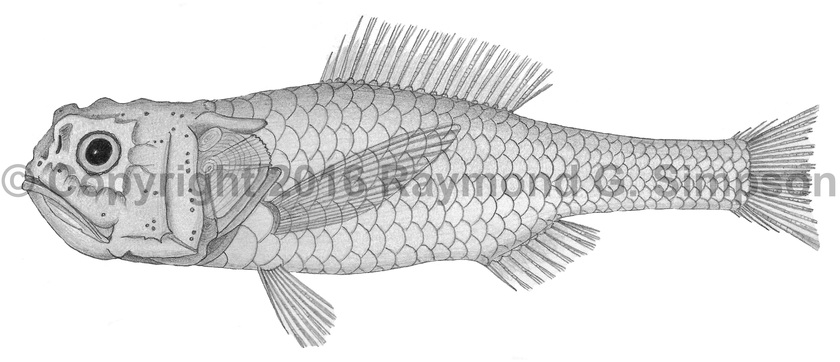
Common Name
Atlantic Smalleyed Bigscale
Year Described
Kotlyar, 2011
Identification
Dorsal Fin: III, 15-16
Anal Fin: I, 7-8
Pectoral Fin: 14-15
Pelvic Fin: I, 7
Caudal Fin: 9-10 branched, 4 procurrent rays
Lateral Scale Rows: 34-35
Gill Rakers: 21-23
Vertebrae: 29
Head with numerous bony ridges and pits. No post-temporal spines, projecting anterior spines, or raised bony crest on top of head. Preopercle and opercle margins relatively smooth or with weak spination. Gill rakers in first arch relatively numerous (20 or more). Anal fin origin under last dorsal ray. Pectoral fin reaches last ray of dorsal fin. Pelvic fin origin under pectoral fin origin. Body scales large and easily shed. Four scales on gill cover. Spur present on first haemal arch of caudal vertebrae.
Color
Body uniformly dark to black.
Size
Maximum size to 87mm SL
Habitat
Taken in midwater and near the bottom from 0-2500m.
Range
Known from the northwestern Atlantic in the Gulf Stream region (off New England north to south of Greenland). Also the NE Atlantic.
References
Bartow, K. W. 2010. Taxonomy and Ecology of the Deep-Pelagic Fish Family Melamphaidae, With Emphasis on Interactions With a Midocean Ridge System. Unpublished PhD dissertation, Florida Atlantic University.
Keene M. J. 1987. Systematics and distribution of the deep-sea fish family Melamphaidae in the Atlantic Ocean. Unpublished Ph.D. dissertation, University of Rhode Island.
Kotlyar, A. N. 2011. Revision of genus Melamphaes (Melamphidae). II. Multi-raker species: M. polylepis, M. falsidicus sp. nova, M. pachystomus sp. nova, M. macrocephalus, M. leprus. Journal of Ichthyology v. 51 (no. 8): 569-580.
Moore, J. A., K. E. Hartel, J. E. Craddock, and J. K. Galbraith. 2003. An annotated list of deepwater fishes from off the New England region, with new area records. Northeastern Naturalist 10(2): 159-248.
Other Notes
Reports of Melamphaes microps from the Atlantic Ocean refer to this species. Closest to M. polylepis in the multi-rakered complex but has fewer lateral scale rows, more dorsal rays on average, pore distribution, and other morphometric measurements (Kotlyar, 2011).
An unpublished species description for “Melamphaes indicoides” in Keene (1987) and Bartow (2010) appears to indicate either M. polylepis, M. falsidicus, or an undescribed species. It’s dorsal fin counts match M. falsidicus but the gill raker counts (20) and scale row count (25-31) are lower than both described Atlantic species.